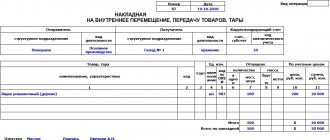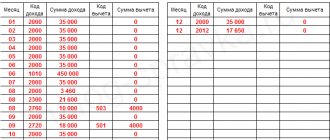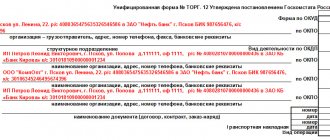Quite often there are cases when an organization must deliver cargo or materials to a certain destination, but it does not have its own transport. In this case, resort to the help of a forwarder. Freight forwarding companies are those companies that deal with transportation from one place to another.
With this type of cooperation, a package of papers is drawn up that contains all the conditions for such transportation. One of the fundamental documents drawn up during transportation is the forwarding receipt. Its design and compilation must be treated with special care.
Peculiarities
The peculiarity of this receipt is that it indicates the temporary transfer of rights to the transportation object to forwarding companies. Also, the forwarding receipt does not contain information about the amount or other conditions of transportation. It contains information about the participants in this transportation of goods, as well as all the main characteristics of the goods being transported, namely: weight, dimensions, packaging, cost of the cargo itself.
Another feature is that this document is needed by all three parties to such a transaction: the shipper, the consignee and the forwarder.
Purpose of the document
The main forwarding documentation is recognized as:
- Assignment to the carrier;
- Warehouse receipt;
- Forwarding receipt.
The carrier generates and issues a receipt only after receiving the cargo, confirming the transfer with this action. In addition, during the transportation of the cargo, the carrier receives a temporary right to possession of it. So why do you need a forwarding receipt? Its issuance confirms the following:
- The cargo has already been sent, and the forwarding company is responsible for fulfilling its transport obligations.
- The packaging is in good condition and has no damage.
- The contents of the receipt are consistent with the instructions given to the carrier.
- The conditions that are specified in the transport documents do not conflict with the responsibilities assumed by the transport company.
What is it for?
All parties to this type of transaction need a forwarding receipt: both the recipient, the sender and the forwarder. For the sender, this document is a guarantee that the transportation company has accepted the cargo from him for this transportation. And this proof is also important for the forwarder himself. Since anything can happen during transportation, this contains basic information about the object being transported.
For the recipient, this document is also important for accepting the cargo for accounting.
After the forwarder has received the goods for transportation and all the accompanying necessary papers have been completed, he is the responsible person for this shipment.
It is important to know that the forwarding receipt does not include information about the conditions of transportation. For this purpose, there is a special document that is drawn up by the sender, and is called an order to the forwarder. It is he who determines the list and conditions of the services provided.
What is the difference between TED and transportation services?
Transport and forwarding activities are a broader concept than simply transporting cargo. In addition to the delivery of material assets from one point to another, TED implies the organization of transportation. The list of transport and forwarding services may include:
● development of the delivery route;
● concluding agreements with other forwarders, carriers and participants in the logistics process for chartering sea and river vessels, aircraft, wagons and cars;
● registration of waybills, bills of lading and other documents necessary for the delivery of goods to their destination;
● payment of transportation tariffs and other payments and fees;
● cargo insurance;
● performing the duties of a customs broker during the transportation of export-import goods;
● informing senders about the progress of goods and their search in case of loss;
● organization of redirection along the route;
● obtaining permits and processing documents for the transportation of dangerous, large and heavy cargo;
● other services on behalf of clients.
Let's imagine that your company is engaged in the production of cotton wool
and you need to deliver products - from the factory to the points of sale. If you use the services of a 2-PL provider or transport organization, you will have to manage the supply chain on your own. The carrier will only deliver the cargo from one place to another. If you hire a forwarding company, the organization of transportation will fall on its shoulders.
Who applies and is it mandatory or not?
From the name of the forwarding receipt it already becomes clear that it is drawn up by the forwarding agent. He must formalize it at the time the cargo is transferred to him. The client must pay the invoice for transportation. Since it includes information about the object of transportation, the sender provides it to the person responsible for transportation.
To account for income tax expenses, you need a package of transportation papers, including a receipt, that is, in other words, a document confirming that the person responsible for transportation accepted the cargo. Thus, the receipt is a mandatory document for accounting and tax purposes.
Validity
The most significant aspect of a power of attorney intended for sending or receiving transport cargo is the validity period of the document.
A power of attorney can be issued:
- to perform one action or a series of actions during one visit to the company (one-time power of attorney). In this situation, it is recommended to indicate the list of actions and the date of the transaction with the transport company. In exceptional cases, for example, when the representative is busy, you can specify a validity period of 1-2 days
- for a certain period (month, year, three years, five years, and so on). A document containing a certain period of validity is a general power of attorney
Does it replace the waybill?
In order to understand whether such documents are interchangeable, let’s consider two situations.
The first situation is that if a forwarder signs an agreement with a company specializing in transportation, then he needs an invoice for the goods. But its preparation does not negate the fact that it is necessary to fill out a receipt. That is, the following picture emerges: the sender transfers the cargo to the forwarder, and a receipt is drawn up that the cargo was received by the forwarder. Purely theoretically, during this period of time and during the transportation period, the cargo belongs to him. Next, the shipment is transferred to the transport company, which, in turn, fills out the transport bill of lading and gives it to the forwarder.
The second situation: if the forwarder transports the cargo himself. In such a situation, a waybill is not required.
But in any case, the receipt does not replace the invoice; these are two different documents and they are drawn up differently, and are intended for different purposes and are accounted for differently in accounting.
In addition, companies providing cargo transportation services are required to fill out travel forms.
Can a receipt be used instead of an invoice?
Often citizens have a question about the need for an invoice if there is a receipt. Features of the preparation of various documents include:
- if the party to the agreement is a forwarder, then its transportation costs are confirmed by the relevant forwarding documents;
- the forwarder does not need to issue a bill of lading, but it is a mandatory document for the carrier, who is often involved in the direct transportation of cargo;
- These documents are completely different and cannot replace each other.
If the forwarder independently carries out transportation, and therefore does not involve a third-party carrier, then he does not need a consignment note, so only a receipt is sufficient. The customer can track the cargo using the forwarding receipt in the same way as using other transport documents.
Compilation rules
The form is not approved by law, so it can be filled out arbitrarily in accordance with the organization’s office management rules. Many companies use the old form because it contains all the information they need to fill out.
The document must contain the following information:
- about the client-shipper;
- about the client-consignee;
- forwarder;
- date and serial number of the forwarding receipt;
- information about the cargo itself;
- the number of cargo pieces is indicated.
There should be no blots or mistakes. Moreover, it is strictly forbidden to provide false information, since in some situations this document may have legal significance.
If suddenly a mistake is made somewhere, you should not correct it, but fill it out again. The receipt can be written either by hand or printed. This can be done on the organization's letterhead or on a simple blank sheet of paper.
Moreover, it must contain the signature of the forwarder. As a rule, it is drawn up in two copies (one for the forwarder, the second for the sender). But there are times when more copies are needed. Moreover, each must contain the signature of the originator.
Forwarding receipt form
Filling rules
The receipt form is prepared by printing or using a computer. The document form contains the name located in the center and other details. The form may contain the following reliable and detailed data about the cargo in the appropriate lines:
- date of issue;
- forwarding receipt number assigned to the document by the forwarding agent in accordance with the company’s document flow. This detail is very important: for example, if you know the number of the KIT forwarding receipt, this will help track the cargo on the website of this transport organization. The tracking systems of other carriers operate in a similar way;
- in the line “shipper” information about the legal entity or individual is indicated, including the full name of the legal entity, last name, first name and patronymic of the individual entrepreneur, the place where the permanent executive body of the legal entity or the location of the individual entrepreneur is located;
- the lines “Client” and “Forwarder” are filled in in the same way;
- the corresponding line indicates the country where the cargo was produced;
- the line “Product Code” is intended to include the identification number of the cargo, which may be required when interacting with customs authorities and for statistical purposes or designation and identification of transport;
- marking is affixed in accordance with current legislation;
- “number of places, type of packaging” - this line indicates not only the above information, but also the delivery method (in boxes, in bulk, etc.);
- weight is indicated both with and without packaging;
- the volume and cost are entered in the appropriate columns;
- It is worth specifying additionally special conditions of acceptance for freight forwarding services, the duties of the forwarder and information about the goods, even if they are in the contract;
- The dimensions of the package mean its dimensions and weight (each separately);
- The signature of the forwarder is a required requisite.
Depending on the characteristics of the goods being transported, separate lines are filled in; information about the parties must be indicated in the receipt without fail.
Since transport invoices are not drawn up within the framework of a transport expedition contract, the organization acting as a customer of services has the right to take into account expenses for tax purposes under such a contract only if this paper is available
Together with other documents (an order to the forwarder and a bill of lading signed by the buyer), it is a document in accordance with the Accounting Law, according to which the supplier reflects the sale of goods (recognition of income and write-off of the cost of goods). In addition, its presence is very important when resolving possible disputes: for example, if a situation arises when it is necessary to demand compensation for damage due to damage or loss of cargo. Therefore, the customer of services should not have a question about whether the forwarding receipt is mandatory or not
If it is available, consideration of the dispute in court will be much faster and more efficient.
Why do you need a forwarding receipt?
The forwarding receipt is one of the forwarding documents drawn up in accordance with the procedure for execution and forms of forwarding documents, approved. by order of the Ministry of Transport of the Russian Federation dated February 11, 2008 No. 23 (hereinafter referred to as order No. 23).
According to clause 5 of order No. 23, such documents, in addition to the forwarding receipt, include an order to the forwarding agent and a warehouse receipt.
The forwarding receipt is needed in order to confirm the very fact of acceptance of the cargo by the forwarding agent from the shipper (from the client himself or the person indicated by him).
The remaining forwarding documents are provided for the following:
- instructions to the freight forwarder - to determine the list and conditions for the freight forwarder to provide transportation services to the customer;
- warehouse receipt - to establish the fact that the freight forwarder has accepted the cargo for storage.
IMPORTANT! The forwarding receipt is not the only document confirming the fact of transfer of cargo to the forwarding agent. Failure to draw it up for any reason does not mean that the forwarder will be exempt from liability for the loss of cargo (decision of the RF Supreme Court dated April 20, 2017 No. 309-ES17-3184 in case No. A71-2378/2016).
How to write a forwarding receipt - detailed instructions
- It is imperative to indicate the current date of writing the receipt, corresponding to the date of acceptance of the cargo. Next, enter the number of this document in accordance with the numbering of the company’s document flow.
- Then information about the sender is written, which includes name, address and telephone number.
- Then the same data is written about the recipient.
- And information about the forwarder is indicated. This can simply be his last name, first name, patronymic, or you can additionally indicate passport details.
- The main block contains information about the cargo itself: country of origin, its individual number or barcode, rules and conditions for transporting the goods, or so-called labeling. It is represented by symbols, icons and special designations.
- Then you need to mark the container category. These can be cans, bags, sacks, plastic or cardboard boxes, and the number of spaces they occupy. It is also necessary to indicate the weight of the product with and without a box, the size of all the main parameters and the cost according to receipts.
- Then the conditions of acceptance and terms of services between the client and the forwarder are indicated, namely the obligations of the forwarder for acceptance and transfer, ensuring the safety of the cargo during transportation.
- At the end, the paper is signed by the forwarder with a transcript of the signature. The seal is placed according to desire and possibilities.
Sample of forwarding receipt
Forwarding documents New forms and old rules
Recently, the Russian Ministry of Transport issued Order No. 23 dated February 11, 2008, which approves the forms of forwarding documents and the procedure for their execution. There are three forwarding forms (Table 1); if necessary, other documents may be used, depending on the nature of the freight forwarding services. For example, during international transportation, the parties have the right to stipulate the need to draw up documents other than the existing ones. It is useful to stipulate the need to draw up a forwarder’s report. Where will be indicated, for example, the amounts transferred on account of the transportation contract concluded on behalf of the client, documents confirming delivery to the destination, the amount of remuneration, etc.
Forwarding documents are an integral part of the transport expedition agreement. This means that if any conditions are not specified in the contract, there is no need to draw up additional agreements; the information in the forwarding papers is sufficient.
Table 1 Basic forwarding documents
| No. | Name | Purpose |
| 1 | Instruction to the forwarder | Determines the list and conditions for the provision of transport and forwarding services by the forwarder to the client under the transport forwarding agreement |
| 2 | Forwarding receipt | Confirms the fact that the forwarder has received cargo for transportation from the client or from the shipper specified by him |
| 3 | Warehouse receipt | Confirms the fact that the freight forwarder has accepted the cargo from the client for warehousing |
General scheme and requirements
According to the rules (approved by Decree of the Government of the Russian Federation of September 8, 2006 No. 554), after completing the contract, the client issues a completed and signed order to the forwarder, which provides information about the cargo. The forwarder reviews the order and sends it back to the client with a note of approval or refusal indicating the reasons. From the moment the client receives written approval of the order, it is subject to execution.
The forwarder, upon accepting the cargo, will draw up a forwarding receipt. It gives him the right to own the cargo until the transfer of valuables to the client or the consignee specified in the agreement. In cases where the forwarder accepts the client's cargo for storage, he issues a warehouse receipt to the client.
Now let's move on to filling out the forwarding papers. The rules establish general requirements for all three forms. The forms must be filled out in duplicate. It is acceptable to use printed and computer-printed forms. They are produced on standard sheets of A4 paper in font size No. 14. The name is located in the center of the top of the sheet, printed in capital letters in bold font size No. 16. Documents can be filled out by hand (blue or black pen) or using computer technology. Erasures and blots are not allowed in them.
The lines containing information about the participants (parties) must be filled in. Depending on the nature and properties of the cargo, the corresponding lines of the form regarding information about the cargo are filled out.
The “Order to the Forwarder” form contains the following lines:
- line 1 “Date” —indicates the date the order was issued to the forwarder;
- line 2 “Number” - indicates the number assigned to the forwarder’s order by the client;
- line 3 “Consignor” - indicate the full company name and location of the legal entity; last name, first name, patronymic and place of residence of the individual entrepreneur;
- line 4 “Client” - indicate the full company name and location of the legal entity; last name, first name, patronymic and place of residence of the individual entrepreneur;
- line 5 “Consignee” - indicate the full company name and location of the legal entity; last name, first name, patronymic and place of residence of the individual entrepreneur;
- line 6 “Forwarder” - indicate the full company name and location of the legal entity; last name, first name, patronymic and place of residence of the individual entrepreneur;
- line 7 “Notify the party about the arrival of the cargo” - a note is indicated on the need to notify the shipper or client about the arrival of the cargo (also filled in if there is a need to notify a person other than the consignee about the arrival of the cargo, indicating his company name and location);
- line 8 “Country of origin of the cargo” - indicates the name of the country where the cargo was produced;
- line 9 “Cargo ready for shipment, place, date” - indicate the name of the cargo, the exact address of its location, as well as the date the cargo is ready for shipment;
- line 10 “Mode of transport” - indicates the type of transport on which the cargo is supposed to be transported;
- line 11 “Destination” - indicates the address (point) of cargo delivery;
- line 12 “Insurance” - indicates the number and date of the insurance policy, the full company name of the insurance company (insurer), location, as well as the wording of the insurance conditions relating to a specific shipment (to be filled in at the discretion of the client);
- line 13 “Product code” - indicates the identification number of the cargo intended for customs, transport and statistical purposes;
- line 14 “Marking” - indicates the marking of the cargo in accordance with the legislation of the Russian Federation;
- line 15 “Number of pieces, type of packaging” - indicates the number of packages, as well as how the cargo will be delivered (in bulk, in bulk, in bulk, in boxes, boxes, etc.);
- line 16 “Gross weight, net” - indicates the weight of the cargo with and without packaging;
- line 17 “Volume” - indicate the volume of cargo;
- line 18 “Cost” - indicates the cost of the cargo in accordance with payment documents (to be filled in at the discretion of the client);
- line 19 “Package size” - indicate the dimensions of each package and its weight;
- line 20 “Required documents” - indicates the list of documents attached to the forwarder’s order, necessary for the transportation of goods;
- line 21 “Special notes” - additional information about the cargo is indicated, including a special method of transportation, ensuring environmental safety and the safety of the transported cargo;
- line 22 “Client’s signature” - the personal signature of the client or his authorized person is affixed with a transcript (last name, first name, patronymic).
Legal advice
As was already written above, the receipt is very important not only for the client, but also for the forwarder himself. Its significance for him is determined by the fact that this document is necessary for accepting contract expenses in the inventory account in accounting. That is why you need to fill out the form correctly, without blots and mistakes, and even more so without inaccuracies.
But at the same time, it is important to know that the receipt does not confirm transportation costs, since it does not contain information for the period of transportation. It contains data only about the cargo, the recipient and the sender. An invoice for payment is issued and paid separately. Therefore, to confirm the transportation costs, you need a waybill.
Just like the forwarder, the sender and the recipient are also interested in the entire package of transportation papers for accounting and tax purposes. Transportation companies need documents to confirm the right to use the zero value added tax rate. To the sender and recipient to apply deductions for value added tax regarding the costs of transporting goods under contracts.
Thus, this receipt is a very important document for all participants in the transportation of goods. It is needed for accounting and tax purposes, as well as for the responsibility of the forwarder to clients. Therefore, special attention and accuracy must be paid to filling out and completing this receipt. So that later in the event of any unpleasant situations, there will be a paper confirming the acceptance of the cargo by the transport company.
Do I need to create a receipt?
Forwarding documents are a mandatory part of the expedition contract. They are formed in paper form. Their forms and registration procedure are established at the legislative level, by Order of the Ministry of Transport No. 23. Is a forwarding receipt required or not?
According to the rules of current legislation, a forwarding receipt is a mandatory document. Without it, it is impossible to take into account transport and forwarding costs as part of the costs of corporate revenue tax.
However, within the framework of the contract for transport and forwarding services, other documentation may be used, depending on the characteristics of the services provided. That is, the forwarding paper, which confirms that the carrier has received the cargo, may not be a forwarding receipt, but another paper. The main thing is that this is provided for in a contract drawn up between the parties.
How to become a freight forwarder?
As a rule, the work of a freight forwarder requires a higher technical or economic education (sometimes a secondary specialized education is sufficient). What a forwarder needs to know is a foreign language (some of the most popular are English, German, French, Polish) at a level sufficient for effective communication with foreign clients and partners. Moreover, the more languages you know, the higher you will be valued as a specialist, but you should not forget about your work experience. On our website you can find information about freight forwarder courses in Minsk, St. Petersburg, Moscow, Riga, Odessa, Kyiv, Vladivostok










